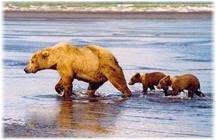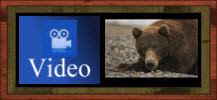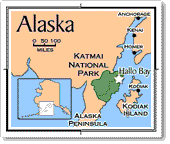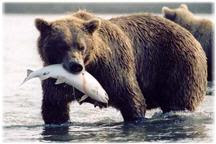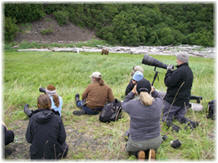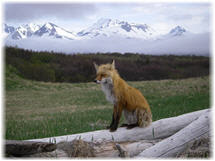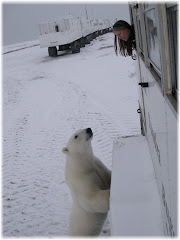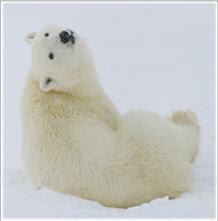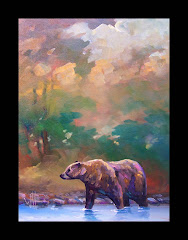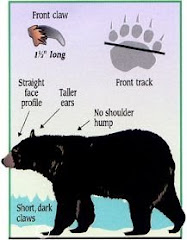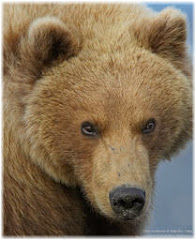- Size
4.7–5.9 inches, .3–.5 oz - Range/Distribution
Deciduous and mixed forests across the north-central US and up into Interior Alaska. - Diet
Insects and seed. - Predators
Very few but known nest predators include red squirrel and black bear. - Reproduction
Single clutch per year with 1 to 13 eggs
Monday, June 30, 2014
Black Capped Chickadee
Sunday, June 29, 2014
Fox
- Size
Weight: 6–15 lbs
Body Length: 22–32 inches
Tail Length: 14–16 inches - Lifespan
3 years - Range/Distribution
It is found throughout Alaska, except for some of the islands of Southeast Alaska and the western Aleutians and is rare in Prince William Sound. - Diet
Omnivorous; eats muskrats, squirrels, hares, birds, eggs, insects, vegetation, carrion, voles. - Predators
Wolves, coyotes, eagles, bears, mountain lions, lynx, humans. - Reproduction
Breed once per year in February and March. Females give birth to litters ranging from 1–10 pups after a 51–54 day gestation period.
Saturday, June 28, 2014
Friday, June 27, 2014
Wednesday, June 25, 2014
Wolf Info
- Between 6,000 and 7,000 wolf skins are still traded across the world each year. The skins are supplied mainly by Russia, Mongolia, and China and are used mainly for coats.
- In India, simple wolf traps are still used. These traps consist of a simple pit, disguised with branches or leaves. The wolves fall in and people then stone them to death.
- Wolves were the first animals to be placed on the U.S. Endangered Species Act list in 1973.
- John Milton’s famous poem “Lycidas” derives its title from the Greek for “wolf cub,” lykideus.
Monday, June 23, 2014
Ermine
Ermine are carnivores that consume mainly small mammals,
especially voles (Microtus spp., Clethrionomys spp.)
and mice (Peromyscus spp). Shrews and rabbits may
also be taken and occasionally other small vertebrates and
insects. Ermine foraging strategies are particularly
well-adapted to northern environments where prolonged snow
cover gives small predators, able to access under-snow
tunnels, a competitive advantage, and where voles are the
most abundant prey species. On Kodiak Island, Alaska,
resident tundra voles (Microtus oeconomus)
provide the bulk of ermine food supply, although these
ermines have also been observed taking fish from a river.
Sunday, June 22, 2014
Eagles
Accounts of eagles carrying off dogs and cats are
unsubstantiated and highly unlikely. An eagle can lift
about three or four pounds, more if it swoops down. Bald
eagles are strong aggressive birds but like everything
that flies, they are governed by aerodynamics. The wings
of an eagle need to support the 8 to 12-pound bird as well
as whatever the bird is carrying and best estimates put
the lifting power of an eagle at about 4 pounds. That
varies, however, depending on the circumstances. Lift is
dependent on air speed as well as wing size. The faster a
bird (or airplane) is flying, the greater the lift
potential. An eagle that lands on the beach to grab a fish
and take off is limited to a smaller load than an eagle
that swoops down at 20 or 30 miles an hour and snatches up
a fish. Momentum and speed give the bird the ability to
carry more weight.
Saturday, June 21, 2014
Friday, June 20, 2014
Beaver
If the habitat does not have the necessary water level,
beavers construct dams. Each dam is a little different. A
beaver may work alone or with family members to build a
dam, using piled logs and trees secured with mud, masses
of plants, rocks, and sticks. Although the average tree
used for construction of a dam is 4 to 12 inches (10–30
cm) across the stump, use of trees up to 150 feet (45 m)
tall and 5 feet (115 cm) across have been recorded. As the
tree snaps, the beaver runs! Very large trees are not
moved but the bark is stripped off and eaten. Smaller
trees are cut into moveable pieces, dragged into the water
for repairing dams and lodges. This work is done mainly in
spring and autumn.
Thursday, June 19, 2014
Ptarmigan
Families of willow ptarmigan join to form flocks in
September. The ptarmigan then begin to move around more
than in the nesting season. Females and males tend to
separate in late September and October; the females,
usually in small groups, seek food and shelter at lower
elevations. In most parts of Alaska these movements to and
from summer ranges encompass only a few miles. Hens that nest or were
reared on the north slope of the Brooks Range move up to
100 miles southward in late fall, wintering on the south
side of the Brooks Range in the low hills and wooded
valleys north of the Yukon River in the east, or in the
valleys of the Noatak and Kobuk Rivers to the west. Males
of these same populations also largely abandon summer
ranges, but do not go as far south as the females. The
south-tending migrations take place in October and
November. The northward movements begin in February, reach
a peak in April, and are finished by mid-May.
Monday, June 16, 2014
Wonderful Wolves
Wolves are skilled and ferocious hunters, but when it it comes to
relationships, they're real softies. When a playmate or partner
leaves the pack, the wolves that are left behind will howl and
howl and howl.
In a new study, researchers report that wolves will give their leaders and their closest allies a longer and stronger serenade if they leave. Those howls could be sonic breadcrumbs, meant to help a lone wolf find its way back to the pack.
In a new study, researchers report that wolves will give their leaders and their closest allies a longer and stronger serenade if they leave. Those howls could be sonic breadcrumbs, meant to help a lone wolf find its way back to the pack.
Sunday, June 15, 2014
Saturday, June 14, 2014
Bear Spirit Names
In many cultures, the bear was looked upon with such reverence
that members of the culture were not allowed to speak the word for
"bear ". Instead, they referred to the animal with varied and
creative euphemisms. These euphemisms are related here. The
general catagory refers to names that were wide-spread through
several native American groups. Many cultures found a spiritual
kinship with the bears, and speaking the name of the animal would
bring swift retribution from the gods.
- Famous Lightfoot (Finn)
- Fine Young Chief (Navajo)
- Food of the Fire (Cree)
- Golden Friend (Finn)
- Golden King (nA)
- Gold Friend of Fen and Forest (Ural Altaic)
- Good-tempered Beast (Cree)
- Great Man (Siberian)
Tuesday, June 10, 2014
Fun Bird Facts
- To attract a mate, a male Frigate bird will blow up its red throat pouch. The pouch can be as big as a person’s head.
- Over time, a surprising number of birds have lost their ability to fly. Being flightless has several advantages. For example, a flightless bird doesn’t need to develop and carry large flight muscles or burn up the energy that flying requires. A flightless bird can also get by with less food, which means it can survive in places where food is scarce.
- Depending on the species, a woodpecker’s tongue can be up to 4" long. It stores this long tongue by curling it in and sticking it through a specialized opening at the back of its neck, where it can then put it between the skull and skin.
- The seagulls in the Alfred Hitchcock movie The Birds (1963) were fed a mixture of wheat and whisky so they would stand around and not fly too much.
- In the movie The Birds (1963), the scene where actress Tippi Hedren is attacked took a week to shoot. The birds were attached to her clothes by long nylon threads so they could not fly away.
Monday, June 9, 2014
Fox
The red fox is omnivorous. Although it might eat
muskrats, squirrels, hares, birds, eggs, insects,
vegetation, and carrion, voles seem to be its preferred
food. Foxes cache excess food when the hunting is good.
They return to these storage sites and have been observed
digging up a cache, inspecting it, and reburying it in the
same spot. Apparently, they want to be sure that their
food is still there.
Sunday, June 8, 2014
River Otter
River otters in Alaska hunt on land and in fresh and
salt water eating snails, mussels, clams, sea urchins,
insects, crabs, shrimp, octopi, frogs, a variety of fish,
and occasionally birds, mammals, and vegetable matter.
Aquatic organisms no bigger than a man's finger are
usually eaten at the surface of the water, while larger
food is taken ashore.
If a fish or other animal is too big to be eaten at one meal, the remains are abandoned and become available to other flesh-eating mammals and birds. Scraps left out of the water may be a significant source of food available to some scavengers when snow and ice are present.
If a fish or other animal is too big to be eaten at one meal, the remains are abandoned and become available to other flesh-eating mammals and birds. Scraps left out of the water may be a significant source of food available to some scavengers when snow and ice are present.
Saturday, June 7, 2014
Bear Facts
- Baloo, from The Jungle Book, is a sloth bear.
- Most bears have 42 teeth, which is about 10 more than people have. A bear’s canines can reach 1.5" long, while a human’s are less than a half inch long.
- The giant panda has been described as a living fossil because it is such an ancient animal.
- Polar bears are the largest land predators on earth. They can stand more than 11' high and weigh more than 1,700 lbs.
- Black bears are typically smaller than grizzly bears, have a smaller shoulder hump, less shaggy fur, longer ears, and a less concave facial profile. Black bear claws are also smaller and more curved to better climb trees.
Friday, June 6, 2014
Thursday, June 5, 2014
Ptarmigan
The willow ptarmigan has an appropriate name. Not only
are willows important nesting habitat, they are also the
bird’s most important food source. The leaves of willow
shrubs often outrank any other item eaten in summer. In
winter the buds, twigs, and catkins of willows provide
four-fifths or more of their food. Because moose and
snowshoe hare also rely on willows for sustenance, it is
fortunate that these shrubs are so widespread in Alaska,
and are able to rapidly recover from severe browsing.
As with the other ptarmigan species, willow ptarmigan feed on berries in the fall and also eat overwintered berries in the spring.
As with the other ptarmigan species, willow ptarmigan feed on berries in the fall and also eat overwintered berries in the spring.
Monday, June 2, 2014
Bald Eagles
The bald eagle’s main diet is fish. Herring, flounder,
pollock, and salmon are taken along the coast, while the
Interior populations prey heavily upon salmon. Eagles also
prey upon waterfowl, small mammals, sea urchins, clams,
crabs, and carrion. Bald eagles are sometimes seen
swimming, laboriously “rowing” with their wings. Eagles
have thick down and float pretty well. It’s a common
misconception that eagles cannot let go of their prey: the
talons’ grasp is purely voluntary. An eagle will sometimes
grab a fish that’s too heavy to lift and will chose to
swim, towing the meal to shore, rather than lose it.
Sunday, June 1, 2014
Alaska Voles
Red-backed voles are omnivorous and will eat grass,
seeds, fruit, lichens, fungi, insects and meat. If a vole
is caught in a trap, others will feed upon the trapped
vole. Both the Microtus and red-backed voles form the base
of the food chain for many animals in Alaska. They are the
staple foods of weasels, marten, foxes, coyotes, all owls,
most hawks, inland breeding gulls, jaegers, and
occasionally great blue herons, domestic cats, northern
pike, and other voles.
Subscribe to:
Posts (Atom)

.jpg)
.jpg)
.JPG)
+(Small).jpg)
+(Small).jpg)
+(Small).jpg)
.jpg)
.jpg)
.jpg)
.jpg)
.jpg)
.jpg)
.jpg)

.jpg)
.jpg)
.jpg)
.jpg)
.jpg)
.jpg)
.jpg)
.jpg)
.jpg)
.jpg)
.jpg)
.jpg)
.jpg)






 Alaska Time
Alaska Time